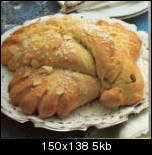Happy Easter!
Wishing you many beautiful Easter eggs and a sunny Easter Sunday.
One of my happiest Easter memories as a child was when my father would design Easter egg
 hunts, complete with fantastic clues. At the end, we would envariably find a rabbit (for a few yeasr, anyway), given to us by Zio. We would name the rabbit Pasquale (that's right, every year). Pasquale would pass his time getting bigger and bigger and chewing on his cage, until one day, Zio would decide he needed to get on with his life and join his jackrabbit cousins in the fields behind our house.
hunts, complete with fantastic clues. At the end, we would envariably find a rabbit (for a few yeasr, anyway), given to us by Zio. We would name the rabbit Pasquale (that's right, every year). Pasquale would pass his time getting bigger and bigger and chewing on his cage, until one day, Zio would decide he needed to get on with his life and join his jackrabbit cousins in the fields behind our house. I don't have room for a rabbit, but I try to make Colomba di Pasqua every year (except this year- the pilot light is out )
I don't have room for a rabbit, but I try to make Colomba di Pasqua every year (except this year- the pilot light is out )If you want to try it yourself, this is a pretty good recipe- it's not exactly like that of Lucca, but pretty close.
Easter Dove Bread #1
Colomba di Pasqua
Makes 1 Loaf
The Colomba is a sweet bread similar to panettone but it is shaped like a dove and made during Easter all over Italy, most of it commercially these days. This bread, along with many others, was prepared on Good Friday and Holy Saturday, and eaten during Easter week. The recipe has come down through the Galasso family.
1/4 cup warm water (110º to 115ºF)
1 tablespoon active dry yeast
1/2 cup warm milk
2/3 cup sugar
8 tablespoons (1 stick) butter or margarine, melted
1 tablespoon grated lemon zest
1 tablespoon vanilla extract
3 large eggs, at room temperature
3 large egg yolks, at room temperature
4 1/2 to 5 cups King Arthur™ Unbleached, All-Purpose Flour
3/4 teaspoon salt
1 large egg white, slightly beaten
1 tablespoon turbinado (raw sugar) or coarse brown sugar
In the large bowl of an electric mixer, put the warm water and yeast and stir to dissolve. Let the mixture proof for 10 minutes. Add the milk, sugar, butter, lemon zest, vanilla, whole eggs, and egg yolks and beat on low speed to blend well. Then beat on medium speed for 3 minutes. Add 4 cups of the flour and the salt and beat on medium speed. Gradually add the remaining flour a little at a time, until a soft dough is formed. You may not need all the flour.
Turn the dough out onto a floured surface and knead until smooth and elastic, about 8 to 10 minutes. Place the dough in an oiled bowl. Cover and let rise until doubled in bulk, about 1 hour.
Punch the dough down, divide it in half, and form 2 balls. Place 1 ball width-wise on a greased baking sheet and gently flatten it into a cylinder 10 inches long and 5 inches thick. Curve the dough slightly in the center.
Pat the other ball of dough into a triangle over the cylinder to form a T. Twist the top third of the body to the right; pinch and shape to form the dove's head, neck, and beak. Twist the bottom third to the left; pull and stretch it into a fan shape to form the tail. With a scissors, cut deep slashes in the wings and tail to resemble feathers.
Cover the dove with a sheet of buttered waxed paper and a towel. Let the bread rise in a warm place until almost doubled, about 20 minutes. Do not let it overrise or the shape will be lost in baking.
Preheat the oven to 350ºF.
Gently brush the dove all over with the egg white and sprinkle the wing tips and tail section with the brown sugar. Bake for about 50 minutes, or until the bread is golden brown. Carefully transfer the bread to a rack to cool.
This recipe is from NELLA CUCINA by Mary Ann Esposito, published by William Morrow and Company Inc., in 1993.
This year Western and Othordox Easter fall on the same day, so...
hugs
Ingrid
<< Home




